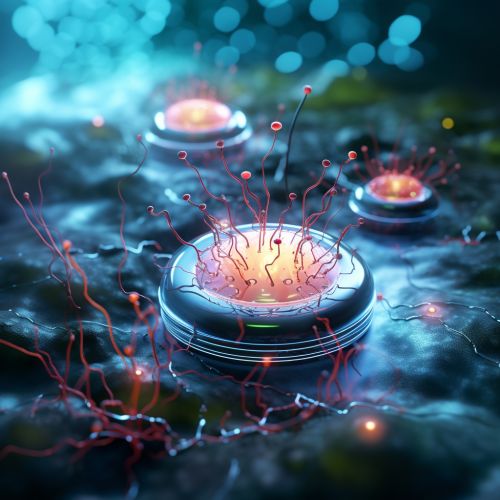Electroactive bacteria
Introduction
Electroactive bacteria are a type of microorganism that can generate electricity. They do this by transferring electrons to an external material or to another cell in a process known as extracellular electron transfer (EET). This unique ability has made them a subject of interest in various fields, including bioenergy production, bioremediation, and bioengineering.
Biology and Mechanism
Electroactive bacteria are typically found in environments with limited oxygen, such as soil and sediments, wastewater, and the human gut. They are capable of performing a type of respiration known as anaerobic respiration, where they use substances other than oxygen as terminal electron acceptors. In the case of electroactive bacteria, these acceptors can be solid surfaces or insoluble substances.


The mechanism of electron transfer in electroactive bacteria is complex and can vary between species. However, it generally involves the movement of electrons from the inside of the cell to the outside. This can be achieved through direct contact, where the bacteria physically attach to the electron acceptor, or through indirect methods, such as the use of electron shuttles or nanowires.
Types of Electroactive Bacteria
There are several types of electroactive bacteria, each with their unique characteristics and mechanisms of electron transfer.
Geobacter
Geobacter is a genus of bacteria that is well-known for its electroactive properties. These bacteria are often found in soil and sediment environments and are capable of reducing a variety of substances, including iron and uranium. Geobacter species are known to use nanowires, hair-like extensions of the cell, to transfer electrons to external surfaces.
Shewanella
Shewanella is another genus of electroactive bacteria. Unlike Geobacter, Shewanella species can transfer electrons to a wide range of substances, including metals, radionuclides, and organic compounds. They can do this through direct contact or by producing soluble electron shuttles.
Other Types
Other types of electroactive bacteria include species from the genera Rhodoferax, Desulfuromonas, and Pseudomonas. These bacteria are less well-studied than Geobacter and Shewanella, but they are known to possess electroactive properties and could potentially be used in various applications.
Applications
The unique abilities of electroactive bacteria have led to their use in a variety of applications.
Bioenergy Production
One of the most promising applications of electroactive bacteria is in the field of bioenergy production. These bacteria can be used in microbial fuel cells (MFCs), where they oxidize organic matter and transfer the resulting electrons to an electrode, generating electricity.
Bioremediation
Electroactive bacteria can also be used in bioremediation, a process that uses microorganisms to remove or neutralize pollutants from a contaminated site. For example, Geobacter species have been used to reduce uranium in contaminated groundwater, converting it from a soluble form to an insoluble form that can be easily removed.
Bioengineering
In the field of bioengineering, electroactive bacteria can be used to create biosensors, devices that use biological molecules to detect the presence of various substances. For example, a biosensor could be designed to use electroactive bacteria to detect the presence of certain pollutants in water.
Future Research
While much has been learned about electroactive bacteria, there is still much to discover. Future research will likely focus on understanding the mechanisms of electron transfer in these organisms, as well as exploring new applications for their unique abilities. Additionally, research will likely continue into the development of more efficient microbial fuel cells and other bioenergy production methods.
